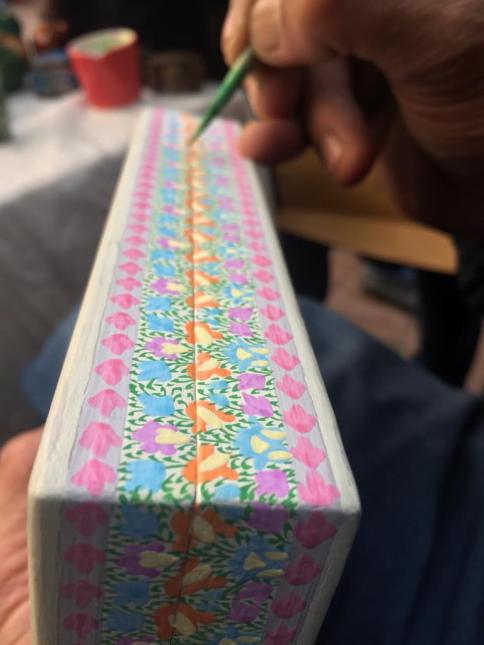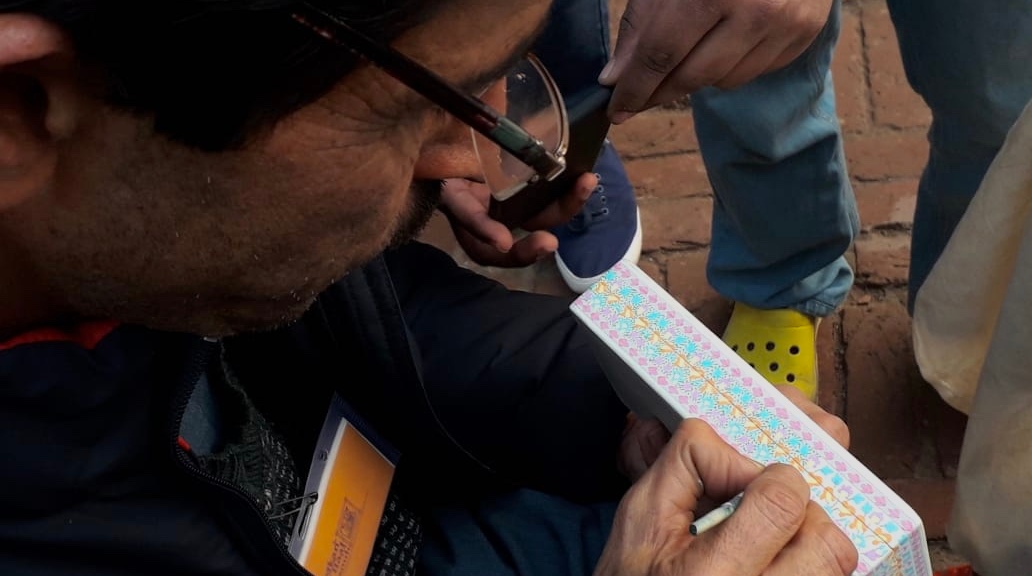I wonder about a day when haats and exhibitions will have ‘authentic’ graphic tees and denim jeans put up in stalls, and visitors might look at them with awe and walk past it. It doesn’t seem that unlikely to me, especially after my recent tour of Dilli Haat.
Of all the things we see around us, most are deliberately crafted works of art—be it an ordinary wooden door, your favourite piece of clothing, or the logo of any popular brand. We barely acknowledge all the visual elements we encounter, let alone recognise the specific functions which they are designed for. Art need not refer to visual adornment alone. Art need not carry heavy visual details even if it does. Art need not be dedicated to abstract ideas. Yet, certain articles are more explicitly labelled as ‘art’ than others.
My mother’s favourite bandhej (tie and dye) saree is much like any ordinary printed tee-top; each is a composition of fabric with a set of dyes combined together into visually pleasant patterns through a planned arrangement of colours. Yet, of the two articles, one is more likely to be recognised as ‘art’ than the other. Both serve the same function as clothing for humans; each differs in the way it is adorned. It is not the intricate design, however, that earns one the label of ‘art’ over the other; It is its status of antiquity.
Many such weaves and embroideries employed laborious techniques, which must have been the most efficient for their times. Now however, the time and labour are not necessary, yet the techniques are preserved—not for superiority, but for authenticity. Now, they are produced for their own sake. Now, their utility as clothing is a secondary function. Now, they are almost a cultural relic.
I wonder about a day when the process of printing graphic tees or weaving denim will become tedious and out-dated, like the process of tying and dyeing is today. The definition of convenient clothing will change, tees and jeans will lose their current popularity, and a day may come when these are but relics of a fading culture. I wonder about it all and I see a day when ‘authentic’ graphic tees and denim jeans would be put up on display at haats and exhibitions for visitors who would look on, exclaim, “Exquisite!” and walk past it.
I had often seen the kani shawls and chanderi dupattas at stalls at Dilli Haat, but never this way. During my last visit, I saw something different. I saw boxes of kar-i-munaqqash, a Kashmiri papier-mache handicraft dating back to the 14th century.
At a distance, artist Syed Ajaz Shah sat working on one of the boxes, with his wrinkled hands and his keen eyes. He sat there to give us a truer picture of his art, truer than what was visible on the boxes; of how he did it and how he lived it. He described the entire process of making a box, tedious and time consuming as it is. Each box is intricately painted, some are detailed with gold. The finesse of details can’t be attained with the regular brushes available in market. He collects the hair dropped from his cat’s fur, sews them into the shaft of a hawk’s feather and makes his own brushes. Painting an average box can take up to twenty days; the practice diminishes the artist’s eyesight over the years; the process is demanding but the product doesn’t pay. Creating this art demands skill; living it in these changing times demands strength.
He told us how he has lived his art through these years. He was awarded with the National Award in 2008 but soon after, close to the brink of poverty, he had to resort to driving auto-rickshaw to make ends meet. The beautiful boxes barely make 200 rupees per day, while his auto earns him 600-800 per day.
His forefathers, as far as he can trace, have been munaqqash artists. He said that when he paints, he holds the brush but it is driven by some other force on its own; the experience is spiritual for him. Yet, neither the legacy nor the magic compels him to pass it on to his next generations.
“I’ll die doing this,” his tone was prophetic, with an odd mixture of sadness and pride in it, “but my sons will never do it.” The second statement was not painful, rather assertive. His assertion had a tinge of relief in it, an acceptance of the inevitability of an end.
It’s not a matter of aesthetic superiority that makes something the trend of the day or elevates it to the status of art. The intricate designs of munaqqashi were used to decorate furniture and household items back in the day; posterity might look back at false eyelashes as antiquity. It’s a matter of evolution. The functional element would remain the same, but the aesthetic element would be always replaced by something new. Yet, certain articles are more likely to be labelled ‘art’. What is the cost of that label? Does it come with being culturally endangered? Is it the reward of representing a lost past?

Written by Eshna Gupta
Edited by Shriya Kotta
Photographs provided by Eshna Gupta

